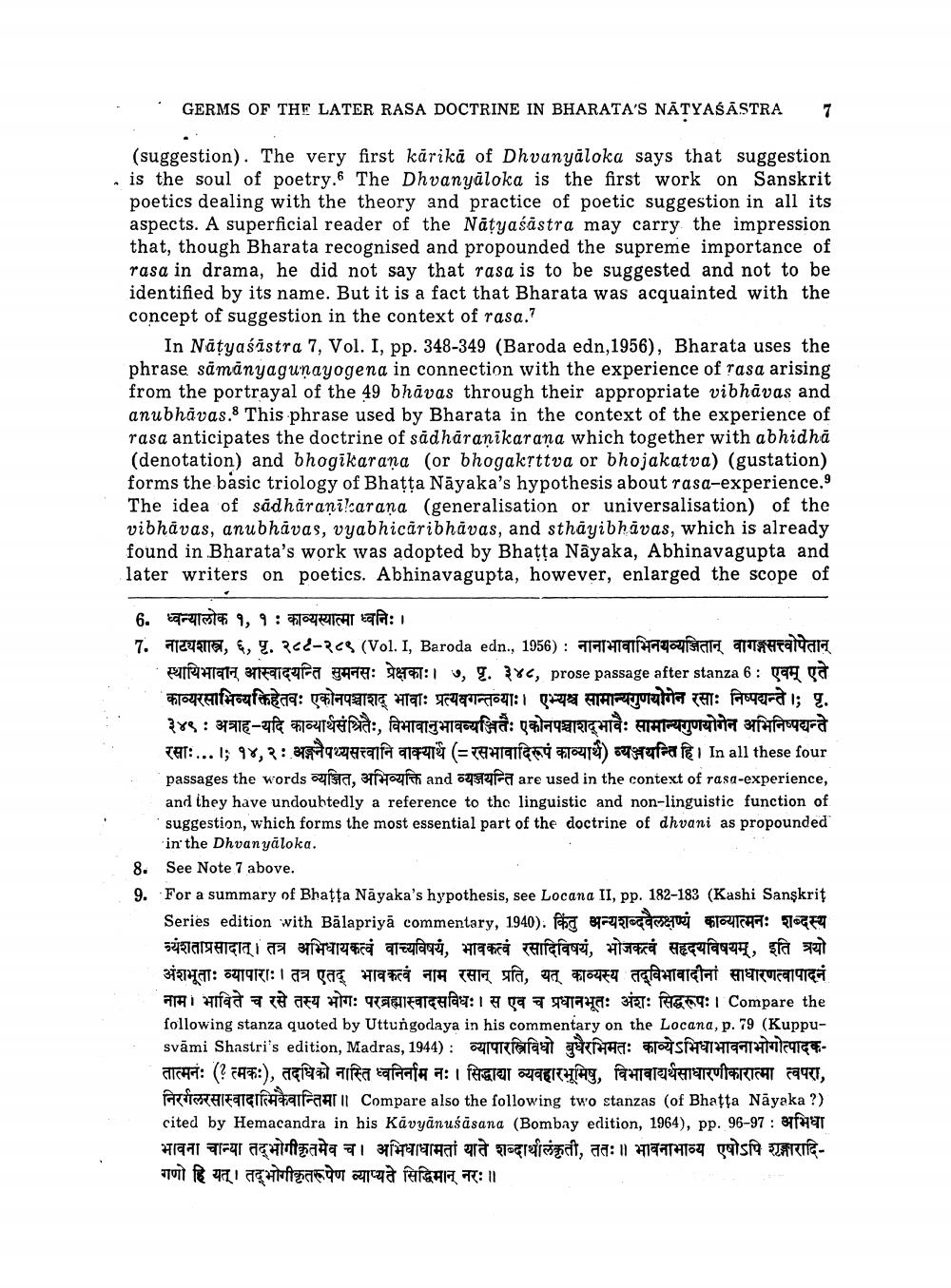________________
GERMS OF THE LATER RASA DOCTRINE IN BHARATA'S NĀTYAŚĀSTRA
(suggestion). The very first karikā of Dhvanyaloka says that suggestion is the soul of poetry. The Dhvanyaloka is the first work on Sanskrit poetics dealing with the theory and practice of poetic suggestion in all its aspects. A superficial reader of the Natyaśāstra may carry the impression that, though Bharata recognised and propounded the supreme importance of rasa in drama, he did not say that rasa is to be suggested and not to be identified by its name. But it is a fact that Bharata was acquainted with the concept of suggestion in the context of rasa.?
___ In Natyasistra 7, Vol. I, pp. 348-349 (Baroda edn,1956), Bharata uses the phrase sāmānyagunayogena in connection with the experience of rasa arising from the portrayal of the 49 bhāvas through their appropriate vibhāvas and anubhāvas. This phrase used by Bharata in the context of the experience of rasa anticipates the doctrine of sadharanikarana which together with abhidhā (denotation) and bhogikarana (or bhogakrttva or bhojakatva) (gustation) forms the basic triology of Bhatta Nāyaka's hypothesis about rasa-experience.9 The idea of sädhäranilcarana (generalisation or universalisation) of the vibhāvas, anubhāvas, vyabhicãribhāvas, and sthāyibhāvas, which is already found in Bharata's work was adopted by Bhatta Nayaka, Abhinavagupta and later writers on poetics. Abhinavagupta, however, enlarged the scope of
6. ध्वन्यालोक १, १ : काव्यस्यात्मा ध्वनिः । 7. नाट्यशास्त्र, ६, पृ. २८८-२८९ (Vol. I, Baroda edn., 1956) : नानाभावाभिनयव्यजितान् वागङ्गसत्त्वोपेतान्
स्थायिभावान् आस्वादयन्ति सुमनसः प्रेक्षकाः। ७, पृ. ३४८, prose passage after stanza 6 : एवम् एते काव्यरसाभिव्यक्तिहेतवः एकोनपञ्चाशद् भावाः प्रत्यवगन्तव्याः। एभ्यश्च सामान्यगुणयोगेन रसाः निष्पद्यन्ते।। पृ. ३४९ : अत्राह-यदि काव्याथसंश्रितैः, विभावानुभावव्यञ्जितैः एकोनपञ्चाशद्भावैः सामान्यगुणयोगेन अभिनिष्पद्यन्ते रसाः...1; १४,२: अङ्गनैपथ्यसत्त्वानि वाक्यार्थ (= रसभावादिरूपं काव्याथै) व्यञ्जयन्ति हि। In all these four passages the words व्यजित, अभिव्यक्ति and व्यञ्जयन्ति are used in the context of rasa-experience, and they have undoubtedly a reference to the linguistic and non-linguistic function of suggestion, which forms the most essential part of the doctrine of dhvani as propounded
in the Dhvanyaloka. 8. See Note 7 above. 9. For a summary of Bhatta Nayaka's hypothesis, see Locana II, pp. 182-183 (Kashi Sanskrit
Series edition with Bilapriya commentary, 1940). किंतु अन्यशब्दवैलक्षण्यं काव्यात्मनः शब्दस्य ज्यशताप्रसादात्। तत्र अभिधायकत्वं वाच्यविषय, भावकत्वं रसादिविषयं, भोजकत्वं सहृदयविषयम्, इति त्रयो अंशभूताः व्यापाराः । तत्र एतद् भावकत्वं नाम रसान् प्रति, यत् काव्यस्य तद्विभावादीनां साधारणत्वापादनं नाम। भाविते च रसे तस्य भोगः परब्रह्मास्वादसविधः। स एव च प्रधानभूतः अंशः सिद्धरूपः। Compare the following stanza quoted by Uttungodaya in his commentary on the Locana, p. 79 (Kuppusvāmi Shastri's edition, Madras, 1944): व्यापारस्त्रिविधो बुधैरभिमतः काव्येऽभिधाभावनाभोगोत्पादकतात्मनः (? त्मकः), तदधिको नास्ति ध्वनि म नः । सिद्धाद्या व्यवहारभूमिषु, विभावाद्यर्थसाधारणीकारात्मा त्वपरा, निरर्गलरसास्वादात्मिकैवान्तिमा॥ Compare also the following two stanzas (of Bhatta Nayaka ?) cited by Hemacandra in his Kavyānusāsana (Bombay edition, 1964), pp. 96-97 : अभिधा भावना चान्या तद्भोगीकृतमेव च। अभिधाधामतां याते शब्दार्थालंकृती, ततः॥ भावनाभाव्य एषोऽपि शृङ्गारादिगणो हि यत् । तद्भोगीकृतरूपेण व्याप्यते सिद्धिमान् नरः॥




